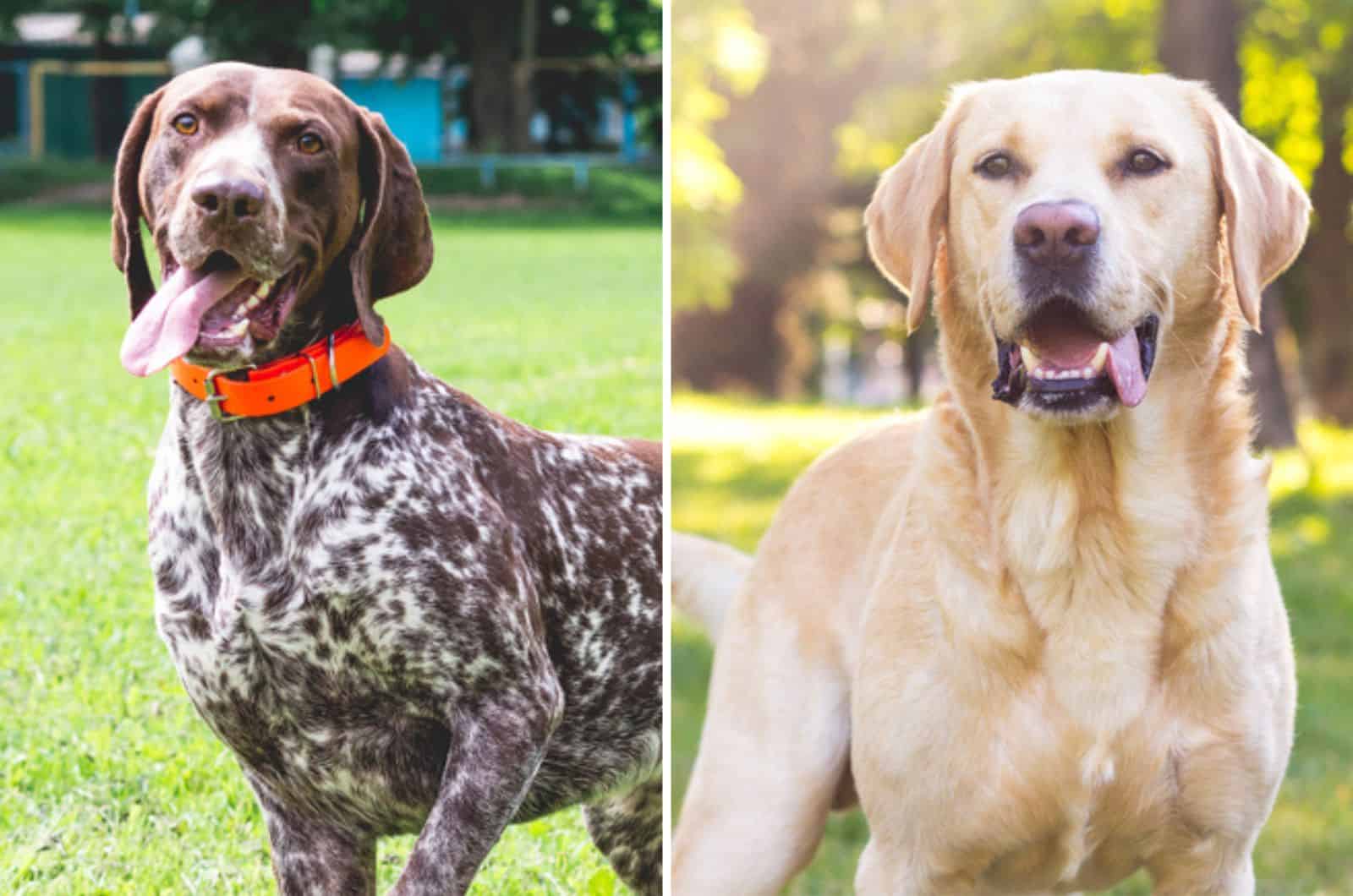If you’re a true hybrid dog enthusiast, then you will be more than happy to come across the wonderful German Shorthaired Pointer Lab mix.
This is probably one of the finest designer dogs in the world, as it has it all – a sporting character, an affectionate nature, and the true heart of a human companion.
As a bonus, you will be pleased to hear that GSP Labs are extremely intelligent dogs, which makes the whole journey even more desirable. Sound interesting? Stay tuned for some more because we are about to throw some interesting facts about this amazing crossbreed!
What Is The German Shorthaired Pointer Lab Mix?

To put it simply… the German Shorthaired Pointer Lab mix is the descendant of a Labrador Retriever and a German Shorthaired Pointer. Both of these parent breeds are extremely popular among dog lovers, especially the Lab.
You can find Lab puppies from the United States all the way to New Zealand. The reason why these pooches are so popular is the fact that they make excellent family dogs as well as decent therapy dogs and service dogs.
On the other hand, GSPs are probably one of the finest German dog breeds there is. These medium-sized canines are super smart, versatile, easily adapted, and great hunters.
All together… the German Shorthaired Lab happens to carry the finest traits of both purebred parents, which is why these hybrids rank high in the club of mixed breeds.
There is one catch, though. These pooches seek active families, as they are active themselves. If you’re interested in a smooth, lazy lifestyle with your doggie companion – don’t bother getting one. A GSP Lab is not that!
Meet The Parents

The best way to meet this wonderful mixed breed dog is if we start with its parents first. On one hand, we have the amazing Lab, which is probably the most famous dog breed in the world at this moment.
On the other hand, the GSP dog is an up-and-coming breed in the U.S. that still seeks proper representation. These working dogs are often misperceived as aggressive and vigilant, but the truth is they are extremely loyal, obedient, and home-friendly.
If you are willing to buy one of these German beauties – do it right! Choose only the finest GSP breeders on the market, as that way, you will get the whole package.
That said, high-quality breeders will make sure you get a trained, socialized, and well-mannered GSP from the start, which will save you extra work in the future.
Now, a combined presentation of the two breeds doesn’t give justice to these puppies. Let’s take a quick tour through both breeds’ facts individually!
German Shorthaired Pointer
Both male and female GSPs make wonderful family dogs, as they are naturally loyal, obedient, and owner-pleasers. The breed is a long-term member of the American Kennel Club, with almost a hundred-year-long tradition.
These canines weigh around 55 to 70 pounds on average, and their average height revolves between 23 and 25 inches. That said, GSPs belong to the club of medium to large dog breeds.
These canines were originally used as hunting dogs and working dogs in Germany. Nowadays, most GSPs are bred for family purposes. However, the breed still seeks high-intensity training and a purposeful lifestyle, as they are high-energy by default.
The breed has a short, smooth coat that sheds moderately. In order to avoid hair trails all over the house during the shedding seasons, the use of de-shedding tools is highly recommended.
These canines mostly come in liver, liver and white, black, and black and white color patterns.
When it comes to their temperament, GSPs are low-maintenance dogs that enjoy pleasing their owner. They are easily trained, eager to play at all times, and they get along with all family members just fine. Additionally, GSPs are great with small children and other pets.
Labrador Retriever
Even though there are countless articles out there on a Labrador Retriever, there are still not enough words to describe the gentle nature of this golden dog.
These puppies are not on top of the list of the most desirable dogs in the world by accident, neither are they boring, mainstream news.
Simply… Lab puppies, originally bred in Newfoundland, are there to serve, love, and play. They are easily trained, both indoors and outdoors, which is why they are perfect for first-time dog owners.
Labs respond to positive reinforcement excellently, as they love being mentally challenged and engaged in various activities.
This breed belongs to the large dog breed club. The average Lab dog stands up to 24.5 inches in height. On the other hand, these canines weigh 65 to 80 pounds, which makes them slightly bigger than their GSP counterparts.
The breed has a short coat with an extra undercoat beneath. Their water-resistant coat makes them ideal for swimming sports, although the breed won’t mind being challenged by frisbee fetching either.
Generally, all Labs and the majority of Lab mixes are healthy dogs that live up to 13 years. During their lifetime, they may face several minor issues such as hip dysplasia, bloat, ear infections, and several eye problems.
A Little Walk Through The Crossbreed’s History
Even though the history of the German Shorthaired Pointer Lab mix is still vague concerning the details, the history of its parents is quite familiar.
Lab puppies have more than a five-century-old origin, and they originally come from Canada. Even though the breed got its name from the Labrador province, these pooches originally come from Newfoundland.
The original purpose of Lab dogs was retrieving small game from the water, which is why to this day Lab puppies enjoy swimming sports.
Nowadays, both American and English Lab breeders sell these canines as all-time-favorite family dogs. Their exquisite intelligence, high tolerance level, and affectionate nature make them ideal for big families, as well as for families with small children.
On the other hand, GSP puppies were originally used in Germany for hunting purposes. Their athletic body physique and excellent stamina, combined with a high prey drive, make them ideal for hunting both big and small game.
Nowadays, GSPs are bred for family purposes most of the time, but they also make decent watchdogs and guard dogs.
Physical Appearance

Lab Pointer mixes generally have a strong body, a long muzzle, and floppy ears that are softly covered with fur. These mix puppies are medium to large dogs that have either a short coat or a double coat that is water resistant.
They can come in both Lab and GSP coat colors, which is why you can find your GSP Lab in red, white, brown, black, yellow, liver, gray and parti-color. Chocolate Lab GSPs are not rare either!
These canines require a lot of exercise during the day, which is why you need to take them out at least two times a day in one-hour intervals.
Due to their super-athletic body inherited from the GSP parent, GSP Labs are extremely active dogs that don’t stand being closed indoors the whole day.
However, these canines are not meant to be outdoor dogs, as they don’t stand solitude.
Size
The average German Shorthaired Pointer Lab mix weighs between 55 and 65 pounds. On the other hand, these pooches are up to 25 inches tall, which makes them medium to large dogs.
Hybrids with a dominant Lab gene are most likely to match the Lab growth chart. However, unlike their Lab parents, these canines are way more athletic.
There is one thing that every responsible GSP Lab owner should pay attention to – these designer dogs are prone to obesity. Despite their athletic setup, they can easily get overweight, which is why you need to carefully design their feeding chart.
Avoid dog food with a high percentage of processed carbs, as well as junk food. Instead, try giving your pooch high-protein food combined with green fibers.
Coat Type And Coat Color
When it comes to their coat type – there are two possibilities. You can have either a Lab GSP with a short, smooth coat, which is a characteristic of their GSP parent, or you can come across a double-coated canine with a waterproof undercoat.
In both cases, you will need to brush them on a daily basis if you want your pet to remain neat and shiny. Aside from that, they will need a bath every two to three months or so.
These pooches come in both GSP and Lab Retriever colors. That said, your future pet will appear in red, liver, yellow, chocolate, white, black, or a parti-color.
Despite not being as fashionable as some other long, curly-coated breeds, these puppies are still adorable in their appearance.
Temperament Of A German Shorthaired Pointer Lab Mix

The German Shorthaired Pointer Lab mix is an extremely loyal, affectionate, and playful dog that fits in all types of families. Additionally, these pooches are quite intelligent, as both Labs and GSPs belong to the club of the smartest dog breeds in the world.
Generally, you will not have a problem socializing with them, nor teaching them how to go potty. Still, due to their high prey drive, these puppies will need a lot of mental stimulation and engagement, as they don’t stand being left out, even for a few hours.
They are not as clingy as Chis or Pugs, but they do require a certain amount of commitment. If you have a much too busy schedule to be around your GSP Lab, the recommendation is to go for a less demanding breed.
Socialization And Housing
Even though German Shorthaired Pointer Lab mixes are medium to large dogs, they adapt to indoor life quite easily. In fact, these dogs don’t have the best time living outdoors, as they can experience severe separation anxiety.
Over the years, both Labs and GSPs have learned how to behave inside a house, which is why their offspring won’t have a problem adapting either.
When it comes to socialization, the use of interactive dog toys is highly encouraged during their puppyhood stage. These canines respond decently to positive reinforcement, which is why they won’t have a problem socializing with all family members.
Additionally, they make great companions for other pets and children.
Aggressiveness
If you’re worried that your future pet will be aggressive – be at ease! Their Lab parents are known to be one of the least aggressive dogs in the world, which is why you can expect nothing less from your GSP Lab.
On the other hand, GSP dogs can be aggressive once they feel threatened. It is highly unlikely that they will display aggressive behavior out of nowhere, though. Unlike German Shepherds, this German breed is far more sociable and far less vigilant.
A kind reminder to future GSP Lab owners is to never let your dog be alone for more than a few hours. Puppies with separation anxiety issues can be self-destructive and aggressive at times, which is something you don’t want in your pet.
Trainability
Indeed, both Labs and GSPs are great on the training court. In fact, these puppies will gladly use a dog park, a back yard, or a street as their playfield. That said, these pooches are extremely easy to train, as they just love being challenged both physically and mentally.
In fact, their Lab parents are known to be one of the easiest dogs to potty train.
Still, you should subject your puppy to early training, as the training process during the puppyhood stage is far easier than during adulthood.
GSP Labs naturally appear as obedient, loyal, and owner-pleasers, but they do require a certain amount of manner-teaching.
Health Issues Of A GSP Lab Mix

If you have already fallen in love with the GSP Lab – you’re in luck! These pooches come from two very healthy parents, as both Labs and GSPs are known to be among the healthiest breeds in the world.
That said, these medium to large-size puppies are most likely to live a long, happy life without any major health problems.
Their average lifespan revolves between 10 and 13 years, which is quite respectable for a dog this big.
Still, some GSP Labs can face several minor issues such as hip dysplasia, stomach torsion (or bloat), and entropion.
Hip Dysplasia
Canine hip dysplasia is a common issue that is mostly related to large breeds. It is characterized by hip malfunction, which results in a bunny walk.
Once you notice symptoms such as lethargy, reluctance to perform basic puppy activities, or pain in the groin – you should pay your veterinarian a visit at your earliest convenience.
Namely, the condition itself is not fatal, but it can cause further injuries, such as a bone fracture.
There are two things recommended to owners of dogs with hip dysplasia – keep them within a normal weight ratio, and keep them away from overwhelming activities.
This condition is treated surgically. However, hip dysplasia surgery is not that cheap, which is why you should consider getting pet insurance to cover your potential expenses.
Bloat
Unlike dysplasia, bloat is not a hereditary condition, as it develops over time, and it is caused by external factors. The number one trigger of bloat is an improper dietary regime of your dog.
Bloating happens when a puppy’s stomach is being filled with gas. Bloat, or popularly known as stomach torsion, is manifested in a swollen stomach, severe stomach ache, panting, breathing heavily, lethargy, and lack of appetite.
Some bloat-affected dogs even refuse to drink water.
There are two things that any dog owner must do in case their pet gets affected with bloat. First, you should subject your puppy to a veterinarian exam as soon as you notice the first symptoms, as untreated bloat can be fatal.
Second, make sure your puppy gets food that is enriched with green fibers, as unprocessed carbs and dry kibble can be a trigger for bloat.
Entropion
Entropion in dogs happens when the eyelid rolls inwards, causing redness, itchiness, discomfort, and light sensitivity.
This is generally not a serious issue, as puppies with entropion recover within a few weeks. However, in some cases, entropion can cause corneal ulceration, which can either cause a white or a blue cornea.
This condition is treated surgically.
FAQs
1. Are Pointer Lab Mixes Good Dogs?
Indeed, these hybrids are considered to be humans’ best friend. Their natural affection, loyalty, and playful character make GSP Labs ideal even for first-time dog owners.
Both Labs and GSPs are known for their loyalty and good nature. The first-mentioned, aside from being the most popular dog in the world, is an excellent therapy dog, and one of the best family breeds in the world.
2. How Much Is A German Shorthaired Pointer Lab Mix?
Generally, these canines cost between $500 and $1500. However, the price at reputable breeders may be even higher, as they provide extra supplements for their puppies such as their first pack of food, a microchip, a dog training collar, and a leash.
It is always better to buy a puppy from a high-quality breeder, especially if we take into consideration that those puppies are (without exception) subjected to early DNA tests, health exams, vaccinations, and deworming.
Conclusion
The German Shorthaired Pointer Lab mix is one of a kind. These hybrid dogs rank high on the list of the most desirable crossbreeds due to their impeccable nature and good origin.
Both Labs and GSPs are known to be decent family members, which leaves zero chance for their offspring to not be the same.
If you’re a hybrid dog enthusiast, and you happen to have a sporting lifestyle – go for it!
Read more: Corgi Lab Mix – The Most Loyal Crossbreed Or A Bad Choice?
